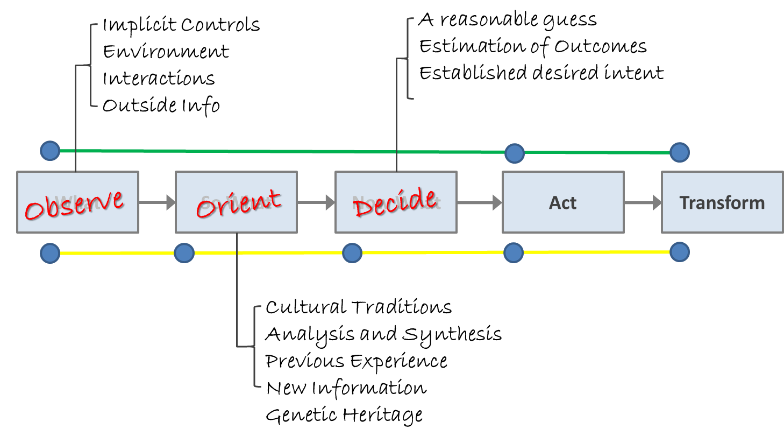
Social Perception
|
Quick question… 1) What is 2+2? 2) What color is an orange? 3) What is the capital of Michigan? 4) Washington? 5) 347+484? |
Perceptions and stereotypes are often incorrect, snap judgements made about a person without facts or evidence. This is an important lesson to learn as we move to the next step.
Shortcuts
Let’s talk about the way our brains work for and against us when we’re not consciously paying attention. Remember the earlier conversation about the elephant and the rider? Another way of looking at this is as an auto-pilot for behavior. Our brains are wired to simplify the world around us and making the majority of decisions somewhere between total consciousness and total unconsciousness.
The human brain is an incredibly complex organ that fills up the pages of entire compendiums of research. So, in the interest of brevity I’m not going to attempt to explain exactly how the brain functions but, in rather general terms explain the basic functions of two parts of the brain. We will explore the conscious, cognitive portion and the unconscious, pre-cognitive portion and for the sake of simplicity I will refer to these two parts as, Conscious and Unconscious.
The Conscious/cognitive portion of the human brain is where the majority of complex thoughts are synthesized. This portion allocates attention to effortful mental activities that demand it, including complex computations. The operations of this portion are often associated with the subjective experience of agency, choice, and concentration. In the book, “Thinking, Fast and Slow”, Daniel Kahneman explains this as the slow thinking portion of the brain. The Conscious mind takes over during intentional critical thinking, when time allows for it, or it realizes that the problem at hand is beyond the scope of the unconscious mind.
The Unconscious/pre-cognitive portion of the human brain is rather similar to that of an animal’s. Anatomically it is nested in the center of the brain – we also know this area as the amygdala. It is programmed based on experiences and makes intuitive decisions in split seconds based on prior programming. This portion of our brain operates automatically and quickly, with little or no effort and no sense of voluntary control. The unconscious mind is the “Fast Thinking” portion of our brain. Many of the topics we discuss at conferences like this rely heavily on this unconscious, intuitive, and reflexive part of our brains. This part of our brain is associated with muscle memory and reflexive shooting. It’s also associated with our emotional intelligence – how we perceive the emotions of others and effectively communicate with them considering their current emotional state.
The first four questions are common ones an average adult can answer intuitively. That is, without consciously thinking about the answer.
As for the more complex math problem, did you break out a pen and paper or did you give up? A lot of people allow their unconscious minds to determine ease of success and risk of failure. The conscious mind takes over only if it must, and the cost of failure is high enough – essentially, our conscious minds are, lazy. Our unconscious minds pilot us through most of life’s events. But the ability of the Unconscious mind to solve problems is only as good as the data we store there – 2+2? Oranges? As for the capital of Michigan, did you say Detroit or Lansing? Washington? Was it Seattle or Olympia?
We learn about others’ feelings and emotions by picking up on information we gather from their physical appearance, and verbal and nonverbal communication. Facial expressions, tone of voice, hand gestures, and body position are just a few examples of ways people communicate without words. A real world example of social perception would be understanding that someone disagrees with what you said when you see them roll their eyes. Closely related to and affected by this is the idea of self-concept, a collection of one’s perceptions and beliefs about oneself.
Dual Process

| Boyd’s OODA Loop and the FTI Model |
Our perception system, the sense-making system that we use as our auto-pilot is not infallible. Remember, our brains are wired to make things easier. This is neither good or bad. If every decision, we make throughout the day had to pass through a cognitive filter we would never get anything done – so our emotional core takes over. The relationship between these two processes is known as emotional-cognitive decision making or dual-process. The emotional portion of our brains will run a program continuously until we intentionally reprogram it. For instance, there may bevegetables we didn’t like as children, but as adults we do. If we had never gone outside of our comfort zone and tried it again we would still view it as a constant. This is where we are reminded of the use of categorization to make the world around us a simpler place to operate.
In Figure 3 – Boyd’s OODA Loop and the FTI Model, you will notice that we have overlaid the Boyd Model[1] on top of our FTI Reasoning Model. The phrase OODA loop refers to the decision cycle of observe, orient, decide, and act, developed by military strategist and USAF Colonel John Boyd. Although Boyd initially applied the concept to fighter pilots it is now common among commercial and academic circles as well. As Boyd suggests we travel mentally through the same process whether deliberately or dynamically. His commonly accepted theory also tells us that the more times a behavior is repeated, deliberately or dynamically that it will become engrained as a matter of our tactical decision making process.
[1] Learn more about Boyd’s OODA Loop, en.wikipedia.org/wiki/OODA_loop
